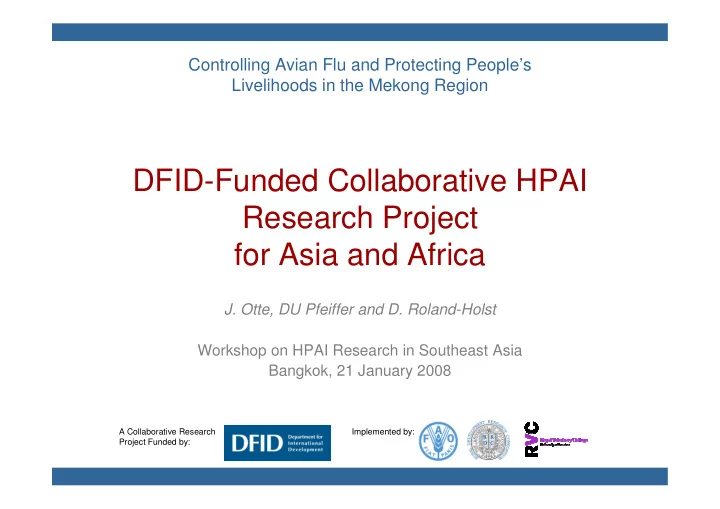

Controlling Avian Flu and Protecting People’s Livelihoods in the Mekong Region DFID-Funded Collaborative HPAI Research Project for Asia and Africa J. Otte, DU Pfeiffer and D. Roland-Holst Workshop on HPAI Research in Southeast Asia Bangkok, 21 January 2008 A Collaborative Research Implemented by: Project Funded by:
Overview • Background & Motivation • Project Goal & Objectives • International Partners & Focal Points • Main Issues (Research & Non-Research) • Principles Controlling Avian Flu and Protecting People’s Livelihoods | Mekong Region
HPAI Threats • Poor peoples’ livelihoods – disease itself – control measures • Poultry industry – in affected countries – in non-affected countries • Global public health – rural populations – urban populations Controlling Avian Flu and Protecting People’s Livelihoods | Mekong Region
Economic Impact of Selected Diseases SARS $50bn China, Hong Kong, Singapore, Canada,… $50bn+ $40bn Estimated Cost Foot & Mouth $30bn UK $30bn $20bn Swine Flu, BSE, UK $10bn Netherlands Foot & Mouth $10-13bn $2.3bn Taiwan, $5-8bn BSE, Canada BSE, US $1.5bn BSE, $3.5bn Nipah, Malaysia Lyme disease Avian Flu, EU Japan $350-400m $500m US, $2.5bn 1.5bn 2004 1996 1997 1998 1999 2000 2001 2002 2003 1992 1993 1994 1995 Controlling Avian Flu and Protecting People’s Livelihoods | Mekong Region �������������������������������������������������������������������������������������������������
Motivation • Approach taken to control HPAI: – top-down / command & control – almost exclusively technical orientation – short on institutional analysis – no use of market-based instruments – anti smallholder bias!! • More of the ‘same’ – laboratory networks – disease ‘intelligence & control centres’ Controlling Avian Flu and Protecting People’s Livelihoods | Mekong Region
Research Issues & Gaps • Differential impacts of • Viral genomics – virus disease and disease evolution control • Pathogenesis – in • Cost-effectiveness / cost- humans and poultry benefit of control • Immunology – vaccine • Institutional angles of development HPAI control • Disease ecology & • Externalities / ‘global epidemiology public goods’ aspects of HPAI control Controlling Avian Flu and Protecting People’s Livelihoods | Mekong Region
Project Goal Safe smallholder poultry enterprises and poultry markets in regions affected or at risk of HPAI while minimizing the potential spread of HPAI to humans Controlling Avian Flu and Protecting People’s Livelihoods | Mekong Region
Project Objectives 1. Provide scientific basis for • cost-effective, and ‘socially just ’ • HPAI control strategies , 2. ‘Inject’ insights into • national, • regional and global policy processes , and Build capacity for evidence- 3. based formulation of disease control policy Controlling Avian Flu and Protecting People’s Livelihoods | Mekong Region
International Partner Institutions International Food Policy Research Institute Clare Narrod, Devesh Roy International Livestock Research Institute Jeff Mariner, Karl Rich Royal Veterinary College, University of London Dirk Pfeiffer RDRC, Berkeley University, California David Roland-Holst, David Zilberman Food & Agriculture Organisation, Rome Joachim Otte, Anni McLeod Controlling Avian Flu and Protecting People’s Livelihoods | Mekong Region
Regional / Country ‘Responsibility’ Indonesia, Ethiopia, Kenya, Nigeria & Ghana / Burkina F. The Mekong Region: Thailand, Cambodia, Vietnam (Lao PDR) Controlling Avian Flu and Protecting People’s Livelihoods | Mekong Region
Research Domains Effectiveness of control measures Economic Incentives impacts for (non-) of control compliance measures Controlling Avian Flu and Protecting People’s Livelihoods | Mekong Region
Effectiveness of Control Measures • Vaccination (vaccine? species? bird type? timing?.....) • ‘Bio-security’ (farm? supply chain? markets? waste mgmt?..) • Culling (radius? timing? tracing?....) • Surveillance (sensitivity? specificity?....) Controlling Avian Flu and Protecting People’s Livelihoods | Mekong Region
Economic Impact of HPAI & Control Viet Nam Thailand Percent Production Processing Distribution Demand Percent Production Processing Distribution Demand 5 5 10 10 15 15 20 20 Rural HH 25 25 Rural HH 30 30 35 35 40 40 45 45 50 50 55 55 60 60 Urban HH 65 65 70 70 75 75 80 Urb HH 80 85 Export 85 90 90 95 95 100 100 HH Farm Ent. Farm Poultry Ind. Food Process Controlling Avian Flu and Protecting People’s Livelihoods | Mekong Region
Economic Impact of HPAI & Control Scale • Within-household • Poultry sectors and supply chain agents • National economy (spillover to / compensatory gains by other sectors) • International / global Time Frame • Short-term / immediate • Long term impacts Controlling Avian Flu and Protecting People’s Livelihoods | Mekong Region
Incentives for Compliance Sterile provinces South North Source: Pfeiffer et al ., 2005 Controlling Avian Flu and Protecting People’s Livelihoods | Mekong Region
‘Non-Research’ Domains Policy makers / advisors Capacity Communication building Field data collectors Research community & data analysts & direct associates Controlling Avian Flu and Protecting People’s Livelihoods | Mekong Region
Project ‘Principles’ • transparent, disclosure of interim findings • collaborative & trans- disciplinary • iterative, ongoing adjustments • constructive peer review • end-user focused • open to partnerships Controlling Avian Flu and Protecting People’s Livelihoods | Mekong Region
http://www.hpai-research.net Controlling Avian Flu and Protecting People’s Livelihoods | Mekong Region
Recommend
More recommend